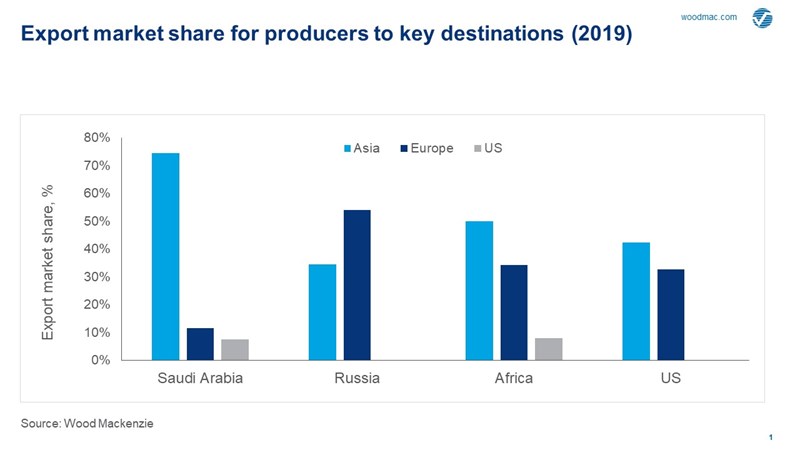Saudi Arabia’s price push for oil market dominance in Asia
Steep discounts on Arab grades’ official selling prices into Asia put pressure on competing Russian and US supplies
1 minute read
Gavin Thompson
Vice Chairman, Energy – Europe, Middle East & Africa

Gavin Thompson
Vice Chairman, Energy – Europe, Middle East & Africa
Gavin oversees our Europe, Middle East and Africa research.
Latest articles by Gavin
-
The Edge
A world first: shipping carbon exports for storage
-
The Edge
WoodMac’s Gas, LNG and the Future of Energy conference: five key themes
-
The Edge
Nigeria’s bold strategy to double oil production
-
The Edge
US tariffs – unpredictability is the strategic planners’ nightmare
-
The Edge
Upside pressure mounts on US gas prices
-
The Edge
The coming geothermal age
The collapse in oil demand following the coronavirus outbreak led to the most significant production cut in history. On 12 April, OPEC+ finalised an agreement to remove 9.7 million b/d of production from May to June this year. From 1 July to the end of 2020, total production will be cut by 7.7 million b/d and output will then reduce by 5.8 million b/d from January 2021 to April 2022.
The agreement was quickly followed by Saudi Arabia announcing the official selling prices (OSP) for its crude oil exports for May. With an almost doubling of discounts to Asian refiners compared to April, the Kingdom gave clear notice of its strategic goal to ensure that its crude remains highly competitive in Asia and of its intent to protect market share in the region against competing supplies from the US, Russia and Africa.
Globally, it is refiners in Asia that will benefit most, with the steepest discounts compared to other regions (Saudi Arabia at the same time raised its May OSPs to US refiners, no doubt leading to minimal volumes of Saudi crude moving to the US next month, particularly given yesterday’s precipitous drop in WTI futures for May). With Saudi Arabia committing to by far the largest share of the OPEC+ cuts through May and June, its subsequent price discounts into Asia and Europe are intended to put pressure on other suppliers to cut prices and/or volumes. Competition is fierce and struggling Asian refiners must now take full advantage of the abundant crude options to maximise their margins.
Asian crude slates to change as competition intensifies
My colleague Sushant Gupta in our APAC Oils team expects crude runs in Asia to recover by about 3 million b/d from their current low to 29 million b/d by June, while OPEC+ production cuts will also be fully in place by this time. This will result in Asian crude markets getting tighter. Sushant believes refiners will then need to draw down inventories built through the first half of 2020 and producers will also be selling crude from inventories by this time, with prices improving as a result.
We are also likely to see changes to Asia’s sources of crude supply. Regional refiners depend on many producers directly impacted by the OPEC+ deal, including Saudi Arabia and Russia, while Asia accounts for a significant share of the exports from these countries. Both Saudi Arabia and Russia will be looking to protect Asian market share as they cut output and are likely to divert production towards Asia from other regions to help ensure this.
Saudi pricing set to secure market share
The major discounts offered by Saudi Aramco for May have ensured that Saudi grades will be highly attractive to Asian refiners. Refining margins for processing Arab Light crude in an Asian refinery with a fluid catalytic cracking configuration will be highly competitive against WTI and Bonny Light benchmark crudes. As a result, the May OSPs should secure Saudi crudes a high market share in Asia, should Aramco choose to supply all volumes requested by Asian buyers. US and African crude grades would need to be further discounted to compete into Asia.
Discounted Saudi grades also need to outweigh the advantage US and African light sweet crudes achieve from the production of very low sulphur fuel oil (VLSFO) for the shipping market. We expect the product’s premium to rise against high sulphur fuel oil from Q3 this year due to the projected recovery in trade and shipping demand and as VLSFO stocks are drawn down over time.
What this means for Russia’s pricing strategy in Asia
Saudi Arabia’s price discounts have put clear pressure on Russian crude pricing in Asia, with Russian crude delivered through the Eastern Siberia-Pacific Ocean (ESPO) pipeline now requiring a deeper discount to the Dubai benchmark to remain competitive. How much of a discount? Sushant reckons that if Saudi Arabia were to maintain its May pricing discount through the rest of 2020, then the ESPO-Dubai differential would need to fall to around -US$6.40/bbl, on average, between April and December.
There is clearly now greater pressure on Russian producers to lower their selling prices to Asian refiners. Russian crude could target greater volumes into Europe of course, but would face similar pressure there as Saudi Arabia has maintained its discounts in Europe. As Sushant puts it, the May OSP announcement would “force Russian crude values lower, if not necessarily volumes”.
Asian refiners set to be the big winners
With its May OSP discounts, Saudi Aramco’s objective is clearly to secure market share in Asia, its largest, fastest growing (in normal times) and most lucrative market. But for Asian refiners, most of which have seen margins hit hard, price discounts on both Saudi grades and other competing crudes represent a welcome opportunity to improve returns and reset their businesses for a return to growth as we slowly emerge from the Covid-19 shutdown.
Read more: Saudi Arabia cuts prices after agreeing to cut production
APAC Energy Buzz is a blog by Wood Mackenzie Asia Pacific Vice Chair, Gavin Thompson. In his blog, Gavin shares the sights and sounds of what’s trending in the region and what’s weighing on business leaders’ minds.







